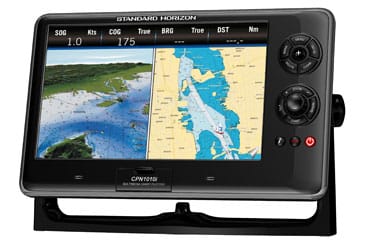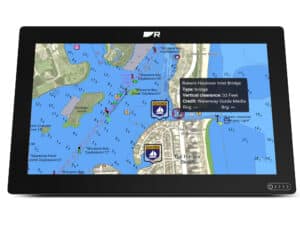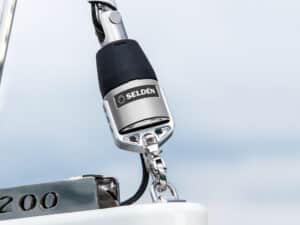
Standard Horizon’s CPN1010i
“Convergence” is the consumer- electronics buzzword for such phenomena as watching television on your PC or browsing the web on your TV. Well, convergence is coming to marine electronics too, but—no surprise!—it’s happening in a more complex, even divergent, fashion.
While dedicated multifunction displays are gaining more features, easily converged boat data is also prompting a resurgence in navigation programs that run on standard computers—and then there’s the intriguing wildcard of wireless devices like the iPad. Thus many forms of convergence will be on display in booths at the Miami Boat Show a few weeks hence, and at the many other shows to follow.
I’m particularly looking forward to the Miami debut of Standard Horizon’s CPN series, which may be the boldest of all convergence experiments. The CPN1010i (pictured above) has the common attributes of a modern M.F.D.: It supports radar and second stations via Ethernet, inputs for cameras, A.I.S. and D.S.C. target tracking, and displays instrument and engine data via NMEA 2000 (though that last feature won’t be enabled until a software update in the fall). The built-in Jeppesen C-Map chart database even includes Mexico and the Bahamas, and this is one of the first M.F.D.s able to display C-Map’s 4D cartography cards, which include paperlike raster as well as vector charts. Using the knob/joystick/button clusters, you can control most underway operations. But when you swipe the sunlight-viewable 1024- by 600-pixel touchscreen, you’ll find an iPad-like button and app environment in which you can not only manage the M.F.D. but also choose tunes to play through the unit’s built-in stereo speakers (or its audio port), select a video or slide show to watch from either of the U.S.B. media ports, or even browse the web and respond to email when in harbor!
The CPNs—they’ll cost about $2,400 for the 10-inch model, $1,400 for a 7-inch version— have not only built-in WiFi but also Bluetooth for mouse and keyboard options to their touchscreen equivalents. And while it wasn’t certain at press time, the CPNs may also offer a choice of overlaying XM’s new online weather service on its charts (when WiFi is available) or accomplishing the same goal by interfacing with a more expensive but more pervasive XM satellite weather (and audio) system. Time will tell how well Standard Horizon executed this smorgasbord of functionality, but it certainly represents the coming together on a single screen of many a cruiser’s digital doings. But, then again, you’ll need to visit some other booths to see all that has converged.
At the Navico booth, you’ll find a passel of novel uses Simrad has added to the NSE Series. For instance, the M.F.D. can serve as a complete head unit for a Simrad autopilot, capable of all calibration tweaks and tight integration with nav functions; regular heads can be used elsewhere on a SimNet/NMEA 2000 backbone but aren’t necessary, saving space and money. With the addition of a $350 black box, three-zone, 200-watt Fusion-built SonicHub AV system, an NSE can also be used to control AM/FM radio, optional Sirius Satellite Radio, U.S.B. media, and any iPod or iPhone that’s inserted in the system’s waterproof dock. Even videos can be shown, in a window or full screen, on the NSE or on another monitor; a remote is available to control the SonicHub when the NSE is shut down. I’ve been testing both the autopilot and A.V. functions and can attest that they don’t appreciably interfere with regular chart and radar use, unless you get into watching movies you rented on iTunes while under way.
I’ve also tested yet another new NSE option, StructureScan side-scanning sonar. While it was developed by Navico-sibling Lowrance primarily so fishermen could image productive bottom detail, I’ve used it to develop a better sense of what’s under my beloved Maine waters than I’d gained in several decades of sometimes feeling my way around. The option costs anywhere from about $650 to $1,400, depending on the transducers needed, and it deserves consideration by inveterate gunkholers and even just especially curious cruisers. And finally, there’s the NSE option I’ve yet to try, which is an interface to BEP’s CZone monitoring and digital switching system. This feature touches hard on the convergence theme as it means that your M.F.D.s can now be used, say, to set all the boat’s lighting the way you like it for night running with a single command, to check on your inverter and solar panels, or to manage a CZone AC panel.
Simrad has also introduced the NSO, a modular system of keypads, monitors, and black-box processor that extends NSE’s networked multifunctionality to larger yachts. And don’t leave the Navico booth without a gander at B&G’s new Zeus M.F.D.s. Yes, they’re rebranded NSEs, including all the options described above, but they’re augmented with goodies like animated GRIB weather files, wind- and boat-speed strip charts, and laylines calculated to polar tables. It’s worth noting that while these sorts of sailing aids were once relegated to specialized PC software, and while Zeus will integrate with high-end B&G instrumentation, it can also play well with more modest gear from other manufacturers and is meant in part for performance-minded cruisers.
The more value-minded might also check out the Lowrance HDS line of M.F.D.s—which support helm and nav-station networking even in screen sizes as small as 5 inches—as they, too, have acquired Navico options like SonicHub, as well as improved embedded Insight charts and second-generation software for sailboat-friendly, low-powered Broadband radar.
The convergence must-see being demonstrated at Raymarine booths is undoubtedly the elegant way that control for the company’s new T-Series thermal night-vision cameras, available thanks to its purchase this year by FLIR Systems, has been incorporated into the combined touchscreen and button interface introduced last year in the E-Wide Series. I’m one of many who’ve already come to appreciate the versatility of that interface, and I was already a fan of the FLIR technology on which the cameras are built. But enough on that for now; you’ll find a complete report on the Raymarine/FLIR marriage in CW’s March issue.
Further good news for the many Raymarine users out there is the new SeaTalk 1-to-SeaTalk ng Converter Kit, which only costs $95 but can provide a simple data pipeline and upgrade path from all sorts of existing sensors and instrumentation to Raymarine’s latest M.F.D. and color all-in-one instrument systems or to other NMEA 2000 compatible gear.
Raymarine has also finalized the nifty “sync to plotter” feature—picture instant wireless route uploads from app phone or pad to M.F.D.—and we can expect to see many more innovations as Raymarine settles in under FLIR’s wing.
Interestingly, you can see another FLIR integration possibility wherever the Furuno/MaxSea family is gathered. Click on an A.I.S. or MARPA target on a TimeZero PC charting screen and the attached thermal camera will automatically pan and zoom to it and outline its field of view on screen. Called “cue and slew,” this valuable feature is definitely headed to Raymarine M.F.D.s, and probably to others, which is what I mean by FLIR’s determination to make night vision ubiquitous. You can also see the new ability of both TimeZero and NavNet 3D to display core chart data from both Navionics and C-Map, of particular importance to those of us who are cruising in regions where coverage can vary substantially between these major vendors. And take a close look at Furuno’s new RD33 bright-color 4.3-inch display, which can handsomely illuminate all sorts of NMEA 2000 and 0183 info and also translate between the two formats. Along with a modest cost in power and money ($600), the RD33 could be a key upgrade tool and/or data workhorse for many nav systems.
Rumor has it that Garmin, too, is adding camera controls—and maybe even night-vision cams—to its ever-expanding multifunction systems. What’s definite, and definitely interesting, is the company’s new GHP 12 sailboat autopilot. Based on the company’s innovative hydraulics-only powerboat self-steerer, the promise is remarkable course-holding abilities along with a control head that nicely matches GMI 10 color instruments; excellent NMEA 2000 networking of wind, heading and other pertinent data; and a special relationship with Garmin M.F.D.s, even as in steering to automatically calculated routes. Note that existing linear drives won’t work with the GHP 12, but that’s an indication of how different this autopilot is.
If you aren’t yet familiar with Garmin’s GPSMap 700 series, an early 2010 surprise, check out a remarkable number of features packed behind a 7-inch touchscreen. While they won’t share charts or radar with other Garmin M.F.D.s, they do support radar by themselves, network well via NMEA 2000, and seem as fast as their bigger cousins.
While wandering among the Big Four of dedicated marine-electronics systems, you may well bump into Geonav, the brand that’s trying to become Number Five. Long based in Italy, Geonav is now the saltwater mark of Johnson Outdoors, which also owns Humminbird along with extensive engineering and manufacturing operations here in the States. And while the brand may not acknowledge sailing quite yet, it certainly exemplifies the current demands of mainstream convergence and what it takes to add something new to the do-it-all category. You’ll see two handsome M.F.D. series along with radars, fishfinders, an autopilot, and numerous Ethernet, NMEA 2000, or NMEA 0183 peripherals. Add to that the option of Side Imaging, which Humminbird actually pioneered and may remain marginally better at than Navico’s StructureScan facsimile. What’s still unique—besides a brand-new interface that seemed interesting in prototype—is the ability to display the most advanced cartography bundles available from both C-Map or Navionics, 4D and Platinum+, respectively. Geonav’s MID 110 multi-instrument display is also unusual in that it has an Ethernet port in addition to NMEA 0183 and 2000. What that means in practice hasn’t been revealed, but what’s possible is 4 colorful inches of auxiliary video, charting, fishfinding, or other moving imagery.
For something entirely different, visit the Digital Yacht booth for the debut of BoatraNet, a dedicated server designed to feed boat-sensor data, Navionics charting, a library of manuals, and more to any combination of onboard WiFi devices that can run an HTML5 web browser. This can or will include all manner of laptops, smartphones, and tablets. BoatraNet will have a separate high-power WiFi Internet connection so that it can keep its own folders synched and re-serve the web to all its client devices.
While few would find such a system up to primary navigation today, and it’s not yet meant for that, Digital Yacht, along with numerous other developers and sailors, envisions a time when radars and other boat-specific Ethernet sensors can share data wirelessly on bright, weather-resistant wireless apps screens that will soon (I’m told) become relatively inexpensive. Then BoatraNet and systems like it could become a new paradigm for converging marine electronics, although by then the Big Four, or Five, may have reached out to wireless devices and the Internet in their own ways: the divergent convergence.
Ben Ellison is CW_’s electronics editor._








